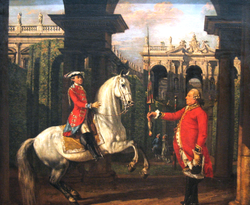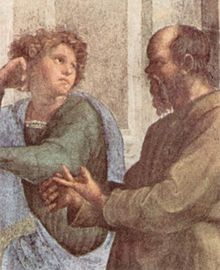- Classical dressage
-
Classical dressage evolved from cavalry movements and training for the battlefield, and has since developed into the competitive dressage seen today. Classical riding is the art of riding in harmony with, rather than against, the horse.
A painting of the Spanish Riding School in 1783
Correct classical riding only occurs when the rider has a good seat and a correct and well-balanced body position, moves with the horse's motion, and gives and times the aids correctly.
Contents
Natural abilities of the horse
The origins of classical dressage and collection lie in the natural ability of the horse and its movements in the wild. In fact, most modern definitions of dressage state that the goal is to have the horse perform under saddle with the degree of athleticism and grace that it naturally shows when free.
Horses naturally use the concept of collection when playing, fighting, competing and courting with each other. When trying to impress other horses they make themselves look bigger, just as other animals do. They achieve this by lifting the forehand, raising the neck and making it bigger by flexing the poll, while at the same time transforming their gaits to emphasize more upwards movement. When fighting, the horse will collect because in collection he can produce lightning speed reactions for kicking, rearing, spinning, striking with the front feet, bucking and jumping.
This natural ability to collect is visible in every horse of any breed, and probably inspired early trainers to reproduce that kind of behavior in more controlled circumstances. This origin also points out why, according to most Classical dressage trainers, every healthy horse, regardless of its breed, can perform classical dressage movements, including the Haute Ecole jumps, or Airs above the ground, even though it may perform them a little differently from the ideal performance due to the build of its body.
A history of classical dressage
The earliest surviving work on many of the principles of classical dressage was Xenophon's On Horsemanship. Xenophon emphasized training the horse through kindness and reward.
In the 15th century, brute force training largely came to an end while artistry in riding was once again coming into its own. Along with these developments came indoor riding. The Renaissance gives rise to a new and enlightened approach to riding as a part of the general cultivation of the arts. By the Victorian age indoor riding had become a sophisticated art, with both rider and horse spending many years perfecting their form. Gueriniere, Eisenberg, Andrade and Marialva write treatises on technique and theory.
The horses were trained for a number of airs or schools, above the ground movements that enabled their riders to escape if surrounded, or to fight more easily. These included movements such as levade, capriole, courbette, and ballotade. Movements still seen today in dressage include the piaffe, passage, and half-pass.
Classical dressage vs. competitive dressage
Modern dressage evolved from the classical school, although it is seen in a slightly different form than its ancestor. Competitive dressage is an international sport ranging from beginner levels to the Olympics. Unlike classical dressage, competitive dressage does not require the aires above ground, which most horses cannot perform well even with correct training, due to physical limitations. Instead, competitive dressage focuses on movements such as the piaffe, passage, half-pass, extended trot, pirouette, and tempi changes.
In theory, competitive dressage should follow the same principles as classical dressage. However, there has been criticism by some riders for the trend at all levels for "quick fixes" and incorrect training that makes the horse appear correct, but that is in fact neglecting the basics. Classical riders criticize such training methods on the grounds that they are biomechanically incompatible with correct movement, are painful to the horse, and cause long-term physical damage. [1] These short-cuts usually catch up to the rider as they move up the levels and need to be correct to perform certain movements. While these modern methods, such as the highly controversial rollkur technique, produce winning animals, classical dressage riders argue that such training is theoretically incorrect and even abusive.
It is also believed by some that competitive dressage does not always reward the most correctly trained horse and rider, especially at the lower levels. For example, some riders who consider themselves to be training classically would not ask their horse to hold his head near-vertical when he first began training, and this would be penalized at the lower levels of competitive dressage, marked down because the horse is not considered to be correctly on the bit. Other riders, who also would consider themselves classically trained, would disagree, saying that if a horse is not ready to travel in a correct outline (on the bit) he is not ready for competition, and this is the reason such horses would be marked down.
The purest form of classical riding, as well as dressage, High School dressage, of Haute Ecole, takes years for both the horse and rider to master. When a horse is advanced in its training, it can perform not only Grand Prix dressage movements such as collected and extended gaits, passage and piaffe, but some can also perform certain "Airs Above the Ground," although usually a horse will only be trained in one air, and only if they are particularly able.
The School Jumps
Main article: Airs above the groundThe "high school" or haute ecole school jumps, popularly known as the "airs above the ground," include the courbette, capriole, levade, and ballotade. Though these movements are said to come from when the horse was used in war, in their modern form, it is unlikely the airs were used in actual battle, as all but the Capriole expose the horse's sensitive underbelly to the weapons of foot soldiers, and it is more likely that they were training exercises used off the battlefield.
The courbette is a movement where the horse balances on its hindlegs and jumps, keeping its forelegs off the ground, thus it "hops" on its hindlegs.
The capriole is a movement where the horse leaps into the air and pulls his forelegs in towards his chest at the height of elevation, while kicking out with his hindlegs.
The levade is a movement where the horse is balanced on its haunches at a 45 degree angle from the ground. It requires great control and balance, and is very strenuous.
There are two main breeds that are most well known for their abilities for airs above ground: the Lipizzaner and the Andalusian. Other breeds that are known for their abilities in High School dressage include the Friesian and Lusitano.
The Spanish Riding School in Vienna, as well as the Cadre Noir in Saumur, still practice and teach the Haute Ecole. The Spanish Riding School exclusively uses Lipizzan stallions for their work.
Today the only remaining large schools of classical dressage are the Cadre Noir, the Spanish Riding School, the Royal Andalusian School of Equestrian Art in Jerez de la Frontera, the Portuguese School of Equestrian Art in Lisbon and the South African Lipizzaners in South Africa. There are independent classical dressage trainers who also endeavor to keep this branch of the art alive, including the Portuguese riding master Nuno Oliveira and his students, Bent Branderup and the American clinicians, Paul Belasik and Dr. Thomas Ritter.
Dressage masters and authors
- Xenophon (427-355 BC): Greek general, the earliest European master with surviving treatises, wrote On Horsemanship which advocated the use of sympathetic training of the horse. Despite living over 2000 years ago, his ideas are still widely praised
- Federico Grisone (mid-16th century): one of the few to write on horsemanship to that point since Xenophon. Was considered a master of his time; his methods are viewed as harsh and cruel by modern standards
- Giovanni Battista Pignatelli (mid- to late-16th century)
- Salomon de La Broue (1530–1610)
- Antoine de Pluvinel (1555–1620): the first of the French riding masters, author of L’Instruction du Roy en l’Exercise de Monter a Cheval, tutor to King Louis XIII, and is the first notable writer to advocate for gentle training since Xenophon
- William Cavendish, 1st Duke of Newcastle (1592–1676): Master of Horse to Charles II of England
- François Robichon de La Guérinière (1688–1751): taught the classical position still used today, introduced the flying change, and had great impact on the Spanish Riding School
- François Baucher (1796–1873): introduced the one-tempi flying change, his method, which is still hotly contested, was based on the fact that the horse's jaw is the source of all resistance; there are two 'manners' by which Baucher is known, the first a more dominant form of riding comparable to the modern rollkur, the second more associated with 'lightness' and a lessening of the hands and legs as the horse progresses
- Count Antoine Cartier D'Aure (1799-1863)
- James Fillis
- Gustav Steinbrecht (1808–1885)
- Maximilian Weyrother director of the Spanish Riding School
- Alois Podhajsky (1898–1973): became director of the Spanish Riding School in 1939; his books in English translation form the basis of Classical Dressage today
- Nuno Oliveira
- Egon von Neindorff (dressage) (1923–2004): author of The Art of Classical Horsemanship
References
External links
- Mini-documentary from Austria, c. 1950s, of Spanish Riding School horses performing
- Dressage Revolution
- Spanish Riding School
- Artistic Dressage
Categories:
Wikimedia Foundation. 2010.





